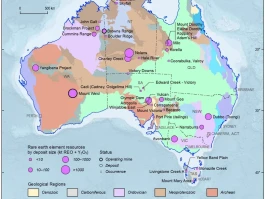You can almost feel the collective, digitized gasp. When the news broke—a fiery social media post from a former president, a retaliatory threat against China’s technological chokehold—the markets didn’t just dip; they plunged. The S&P 500, the Dow, the tech-heavy Nasdaq... all bleeding red. Wall Street saw a trade war reigniting and ran for the hills.
And I get it. The immediate picture is terrifying. China, which produces something like 95% of the world's critical rare-earth magnets, is tightening the screws. Their new export controls are breathtakingly broad, requiring special approval for any product containing even a trace of their rare earths, no matter where it's assembled. In response, Trump threatens to jack up tariffs on China over its new rare-earth controls. It feels like two giants tearing apart the very fabric of our globalized world, and we’re all just caught in the middle.
But I want you to take a step back from the blinking red tickers for a moment. I want you to look past the panic and see what I see. Because this isn't just a crisis. This is a catalyst. This is the painful, terrifying, and absolutely necessary jolt that will redefine the next century of innovation.
The Achilles' Heel We All Ignored
Let’s be honest with ourselves. For decades, we’ve been building a gleaming technological palace on a foundation of sand. We created miracles—smartphones, EVs, MRI machines, advanced jet engines—all while outsourcing the most critical, foundational ingredients to a single source.
These rare-earth elements are the secret spice of modernity. They're not actually "rare" in the ground, but they are incredibly difficult to mine and process cleanly. Think of them like essential vitamins for technology—you only need a tiny amount of neodymium for a powerful magnet or yttrium for a brilliant screen, but without them, the entire system fails. We built an entire global ecosystem that depends on these microscopic inputs, and we allowed the supply chain to become a single, fragile thread stretching across the Pacific. When I first read the specifics of China's new export controls, I honestly just sat back in my chair, a cold feeling washing over me. The sheer audacity and strategic brilliance of it is something to behold—it means the gap between a raw mineral in a Chinese mine and the phone in your pocket is now a political chokepoint, and we simply let it happen.

Is it any wonder the markets are having a "white-knuckle moment," as one analyst put it? We've ignored the profound fragility of this system for years, chasing efficiency and low costs above all else. Now, the bill is coming due. But what if that white-knuckle grip isn't one of fear, but of bracing for acceleration? What if this is the moment we’re forced to grab the wheel and steer in a completely new direction?
A Forcing Function for a Better Future
History is filled with moments like this. Think back to the oil shocks of the 1970s. The sudden, terrifying realization that our entire way of life depended on a few distant nations created widespread panic. It also directly led to one of the greatest periods of innovation in energy history. It gave us more fuel-efficient cars, kickstarted the modern renewable energy movement, and forced a fundamental rethinking of national energy independence.
That was a crisis of energy. This is a crisis of materials. And it will be the forcing function for a revolution in material science that will make the last 50 years look like a warm-up act.
This geopolitical hardball doesn’t just mean we need to find new mines in Australia or the U.S. That’s thinking too small. It means we have to reinvent the entire lifecycle of our technology. Imagine a world where our most valuable mines are not holes in the ground, but the landfills and e-waste dumps we’ve created over the last 30 years. This pressure could finally unlock the massive economic incentive needed for "urban mining"—developing the chemical and robotic processes to perfectly reclaim every last gram of cobalt, lithium, and neodymium from discarded devices.
What about designing products from the ground up to be fully recyclable? Or what about the holy grail: discovering new materials and new manufacturing techniques that don’t require these specific elements at all? Is this the push we need to finally crack room-temperature superconductors or develop magnet-free electric motors? The questions are staggering, and the possibilities are even more so. This isn't about surviving a trade war; it's about being forced to build a truly sustainable, resilient, and decentralized technological civilization.
The Uncomfortable Birth of a New Era
Look, the next few years are going to be rocky. Supply chains will be disrupted. Prices for some goods will likely rise. The transition will be messy and uncomfortable. But complacency is a far greater danger than disruption. This geopolitical shockwave is forcing us off a comfortable but unsustainable path. It’s the universe telling us that the cheap and easy way is over, and it’s time to get serious about building the future we’ve always talked about—one that is smarter, more circular, and not dependent on a single point of failure. This isn’t the end of an era of innovation. It's the beginning of a much more interesting one.

